Exploring Collaborative Learning in Educational Environments
VerifiedAdded on 2020/04/29
|16
|3824
|60
AI Summary
This research paper explores the concept of collaborative learning within educational environments, focusing on its influence on classroom dynamics and student outcomes. The study reviews various methodologies, such as project-based learning and online collaborative platforms, assessing their effectiveness in enhancing engagement and academic achievement. Key findings highlight the benefits of cooperative interactions among students and between teachers and pupils, fostering a supportive learning community. Additionally, challenges associated with implementing these strategies are discussed, providing insights for educators seeking to optimize teaching practices.
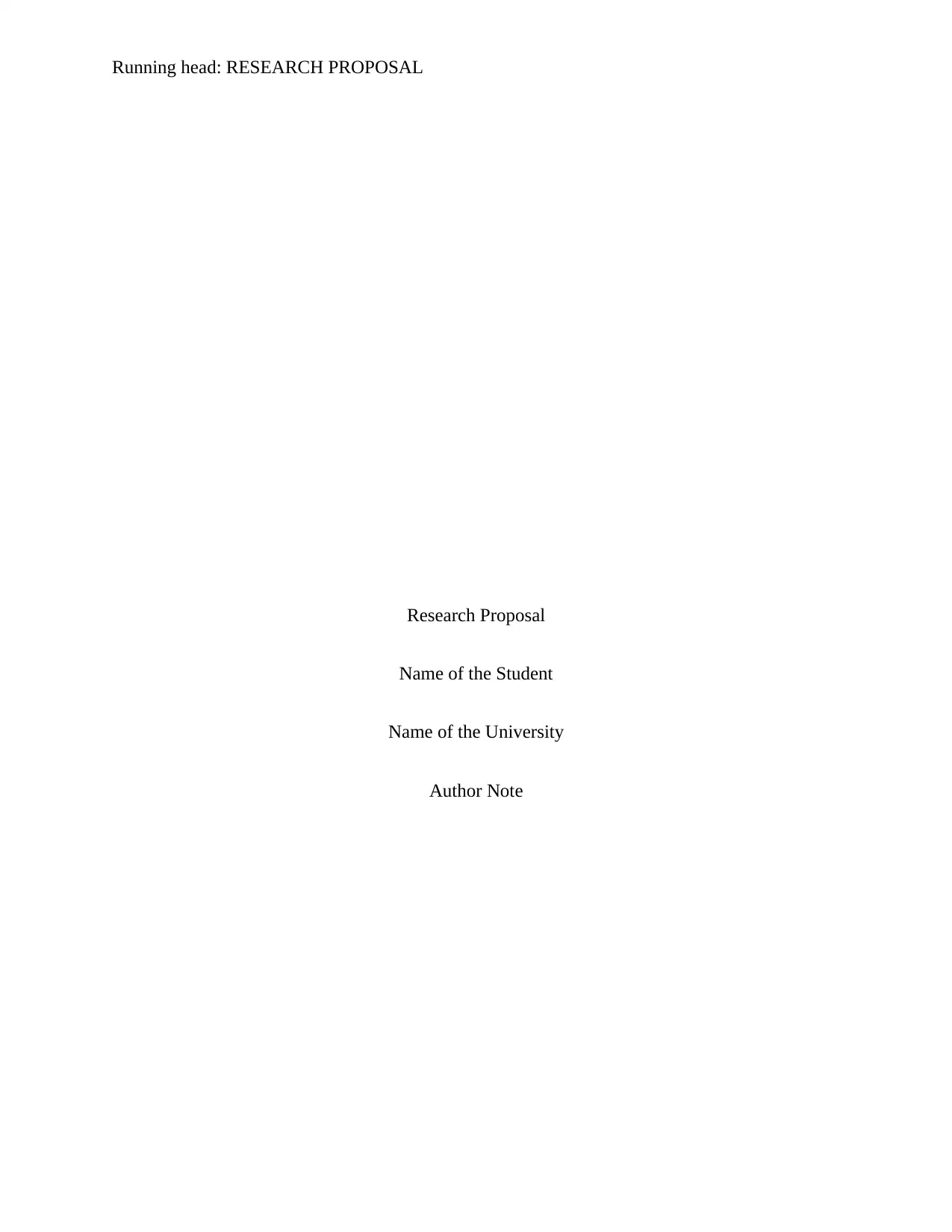
Running head: RESEARCH PROPOSAL
Research Proposal
Name of the Student
Name of the University
Author Note
Research Proposal
Name of the Student
Name of the University
Author Note
Paraphrase This Document
Need a fresh take? Get an instant paraphrase of this document with our AI Paraphraser
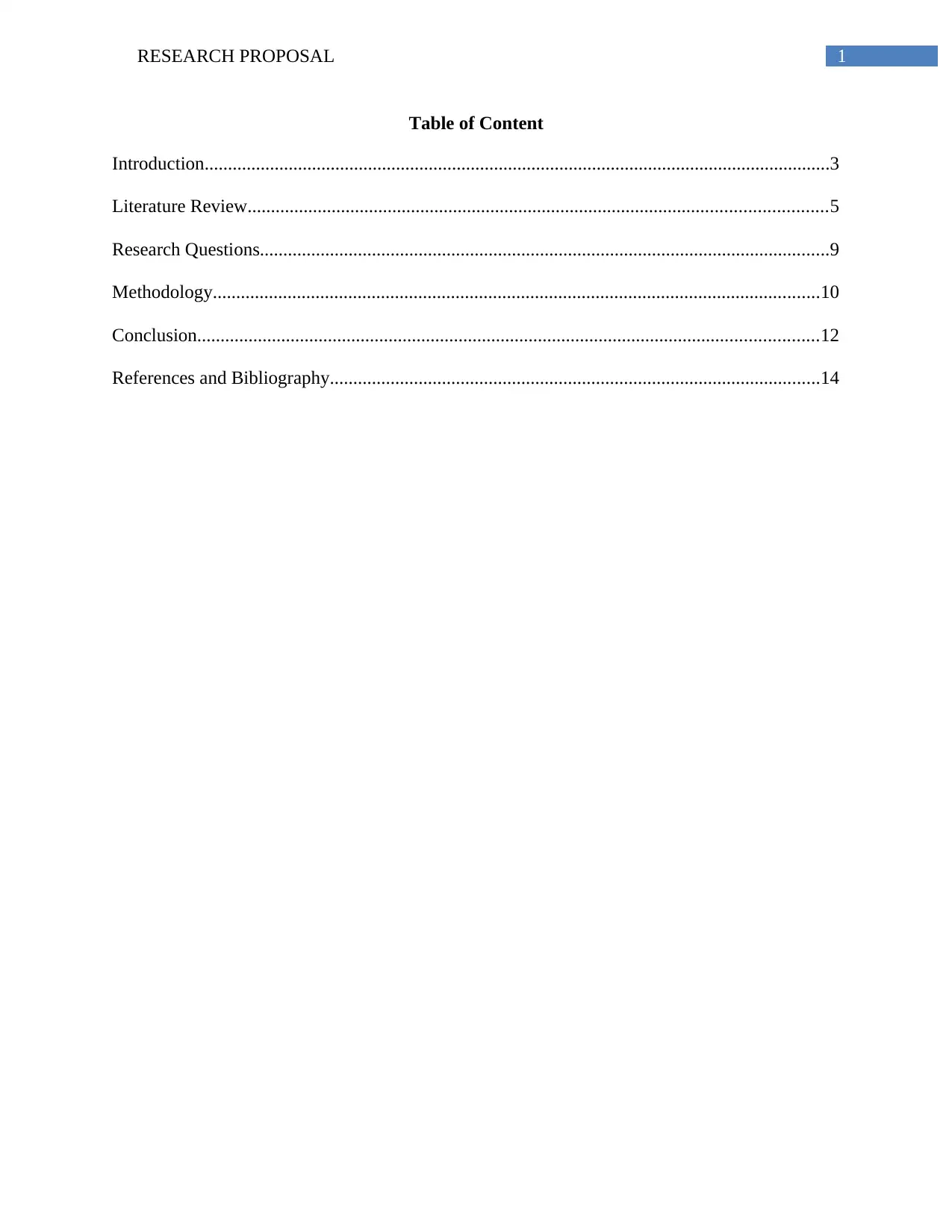
1RESEARCH PROPOSAL
Table of Content
Introduction......................................................................................................................................3
Literature Review............................................................................................................................5
Research Questions..........................................................................................................................9
Methodology..................................................................................................................................10
Conclusion.....................................................................................................................................12
References and Bibliography.........................................................................................................14
Table of Content
Introduction......................................................................................................................................3
Literature Review............................................................................................................................5
Research Questions..........................................................................................................................9
Methodology..................................................................................................................................10
Conclusion.....................................................................................................................................12
References and Bibliography.........................................................................................................14
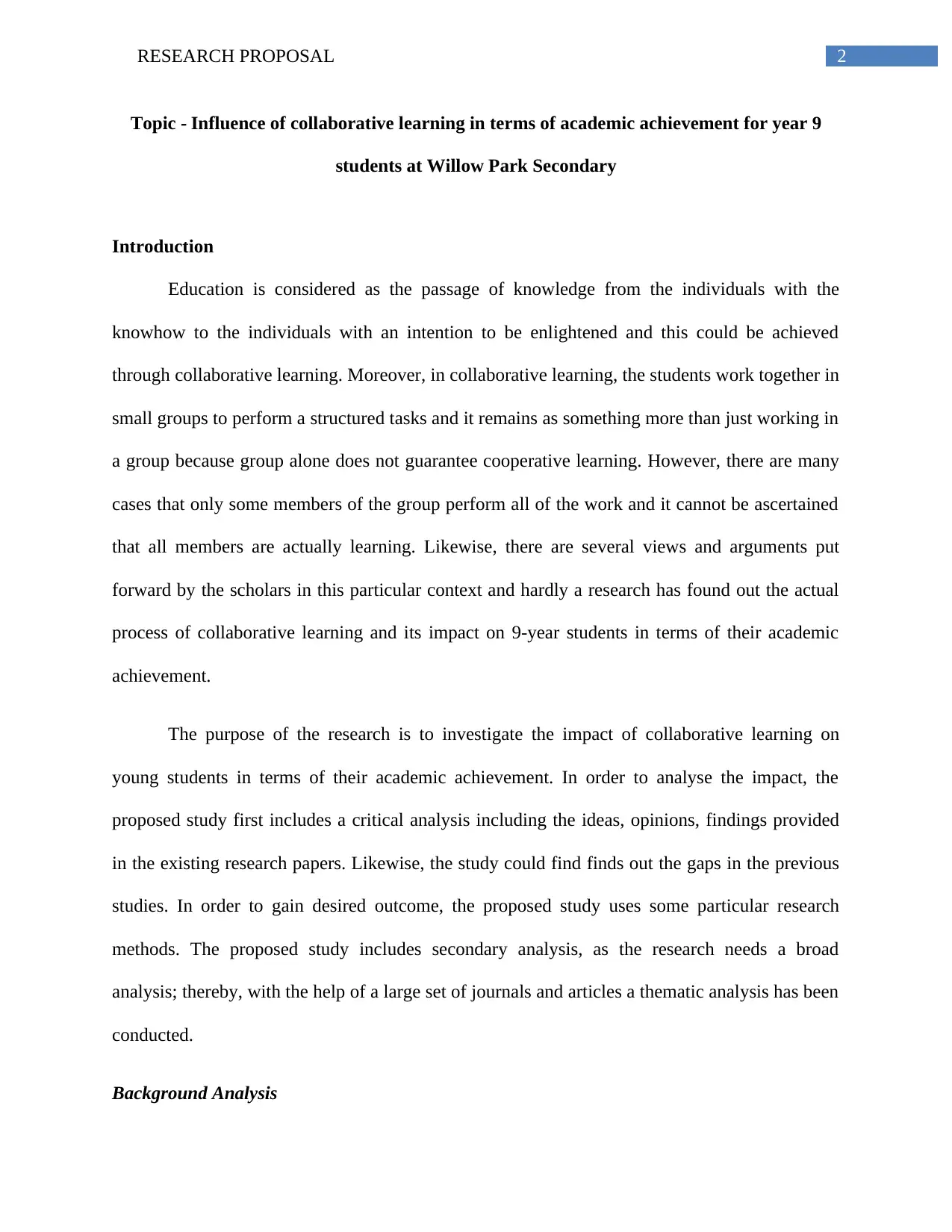
2RESEARCH PROPOSAL
Topic - Influence of collaborative learning in terms of academic achievement for year 9
students at Willow Park Secondary
Introduction
Education is considered as the passage of knowledge from the individuals with the
knowhow to the individuals with an intention to be enlightened and this could be achieved
through collaborative learning. Moreover, in collaborative learning, the students work together in
small groups to perform a structured tasks and it remains as something more than just working in
a group because group alone does not guarantee cooperative learning. However, there are many
cases that only some members of the group perform all of the work and it cannot be ascertained
that all members are actually learning. Likewise, there are several views and arguments put
forward by the scholars in this particular context and hardly a research has found out the actual
process of collaborative learning and its impact on 9-year students in terms of their academic
achievement.
The purpose of the research is to investigate the impact of collaborative learning on
young students in terms of their academic achievement. In order to analyse the impact, the
proposed study first includes a critical analysis including the ideas, opinions, findings provided
in the existing research papers. Likewise, the study could find finds out the gaps in the previous
studies. In order to gain desired outcome, the proposed study uses some particular research
methods. The proposed study includes secondary analysis, as the research needs a broad
analysis; thereby, with the help of a large set of journals and articles a thematic analysis has been
conducted.
Background Analysis
Topic - Influence of collaborative learning in terms of academic achievement for year 9
students at Willow Park Secondary
Introduction
Education is considered as the passage of knowledge from the individuals with the
knowhow to the individuals with an intention to be enlightened and this could be achieved
through collaborative learning. Moreover, in collaborative learning, the students work together in
small groups to perform a structured tasks and it remains as something more than just working in
a group because group alone does not guarantee cooperative learning. However, there are many
cases that only some members of the group perform all of the work and it cannot be ascertained
that all members are actually learning. Likewise, there are several views and arguments put
forward by the scholars in this particular context and hardly a research has found out the actual
process of collaborative learning and its impact on 9-year students in terms of their academic
achievement.
The purpose of the research is to investigate the impact of collaborative learning on
young students in terms of their academic achievement. In order to analyse the impact, the
proposed study first includes a critical analysis including the ideas, opinions, findings provided
in the existing research papers. Likewise, the study could find finds out the gaps in the previous
studies. In order to gain desired outcome, the proposed study uses some particular research
methods. The proposed study includes secondary analysis, as the research needs a broad
analysis; thereby, with the help of a large set of journals and articles a thematic analysis has been
conducted.
Background Analysis
You're viewing a preview
Unlock full access by subscribing today!
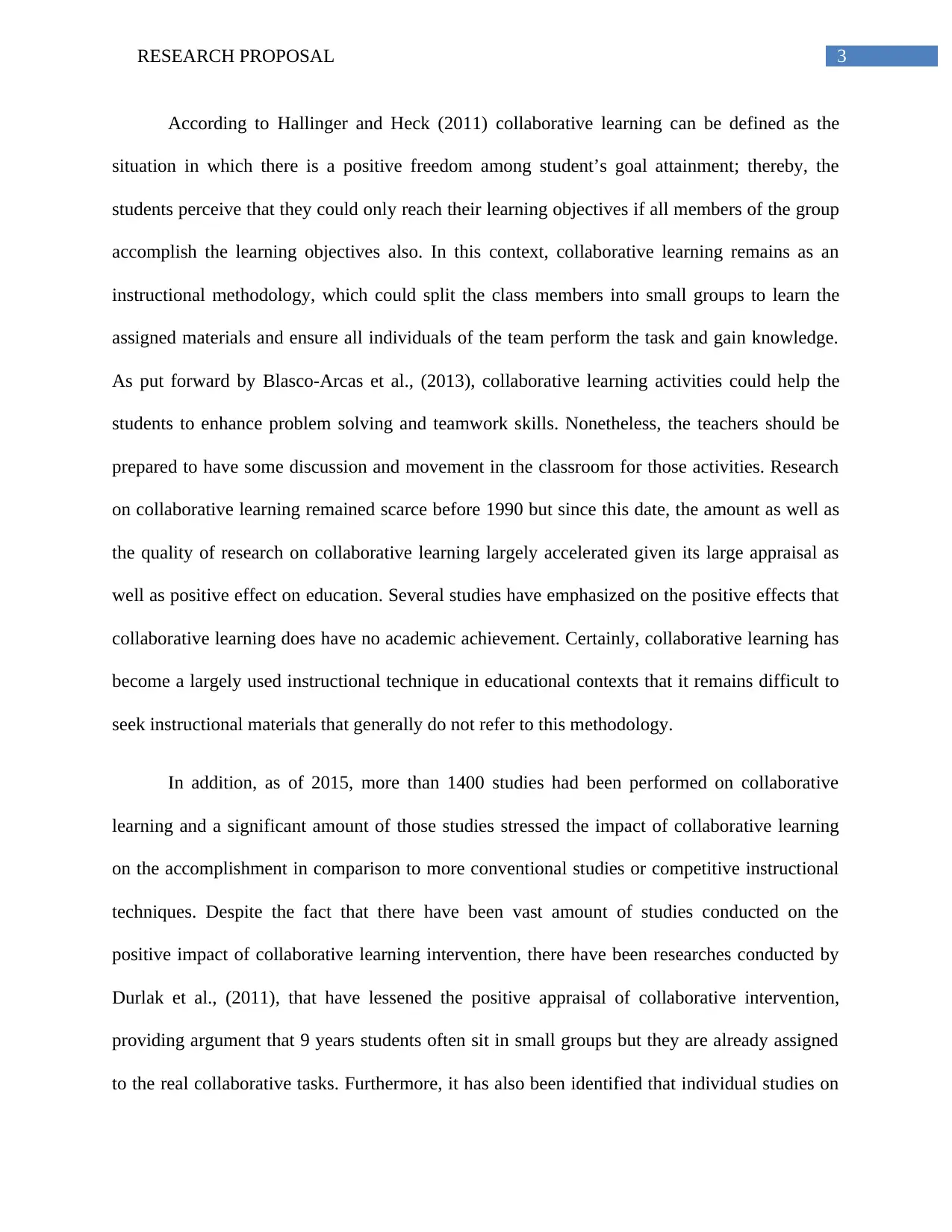
3RESEARCH PROPOSAL
According to Hallinger and Heck (2011) collaborative learning can be defined as the
situation in which there is a positive freedom among student’s goal attainment; thereby, the
students perceive that they could only reach their learning objectives if all members of the group
accomplish the learning objectives also. In this context, collaborative learning remains as an
instructional methodology, which could split the class members into small groups to learn the
assigned materials and ensure all individuals of the team perform the task and gain knowledge.
As put forward by Blasco-Arcas et al., (2013), collaborative learning activities could help the
students to enhance problem solving and teamwork skills. Nonetheless, the teachers should be
prepared to have some discussion and movement in the classroom for those activities. Research
on collaborative learning remained scarce before 1990 but since this date, the amount as well as
the quality of research on collaborative learning largely accelerated given its large appraisal as
well as positive effect on education. Several studies have emphasized on the positive effects that
collaborative learning does have no academic achievement. Certainly, collaborative learning has
become a largely used instructional technique in educational contexts that it remains difficult to
seek instructional materials that generally do not refer to this methodology.
In addition, as of 2015, more than 1400 studies had been performed on collaborative
learning and a significant amount of those studies stressed the impact of collaborative learning
on the accomplishment in comparison to more conventional studies or competitive instructional
techniques. Despite the fact that there have been vast amount of studies conducted on the
positive impact of collaborative learning intervention, there have been researches conducted by
Durlak et al., (2011), that have lessened the positive appraisal of collaborative intervention,
providing argument that 9 years students often sit in small groups but they are already assigned
to the real collaborative tasks. Furthermore, it has also been identified that individual studies on
According to Hallinger and Heck (2011) collaborative learning can be defined as the
situation in which there is a positive freedom among student’s goal attainment; thereby, the
students perceive that they could only reach their learning objectives if all members of the group
accomplish the learning objectives also. In this context, collaborative learning remains as an
instructional methodology, which could split the class members into small groups to learn the
assigned materials and ensure all individuals of the team perform the task and gain knowledge.
As put forward by Blasco-Arcas et al., (2013), collaborative learning activities could help the
students to enhance problem solving and teamwork skills. Nonetheless, the teachers should be
prepared to have some discussion and movement in the classroom for those activities. Research
on collaborative learning remained scarce before 1990 but since this date, the amount as well as
the quality of research on collaborative learning largely accelerated given its large appraisal as
well as positive effect on education. Several studies have emphasized on the positive effects that
collaborative learning does have no academic achievement. Certainly, collaborative learning has
become a largely used instructional technique in educational contexts that it remains difficult to
seek instructional materials that generally do not refer to this methodology.
In addition, as of 2015, more than 1400 studies had been performed on collaborative
learning and a significant amount of those studies stressed the impact of collaborative learning
on the accomplishment in comparison to more conventional studies or competitive instructional
techniques. Despite the fact that there have been vast amount of studies conducted on the
positive impact of collaborative learning intervention, there have been researches conducted by
Durlak et al., (2011), that have lessened the positive appraisal of collaborative intervention,
providing argument that 9 years students often sit in small groups but they are already assigned
to the real collaborative tasks. Furthermore, it has also been identified that individual studies on
Paraphrase This Document
Need a fresh take? Get an instant paraphrase of this document with our AI Paraphraser
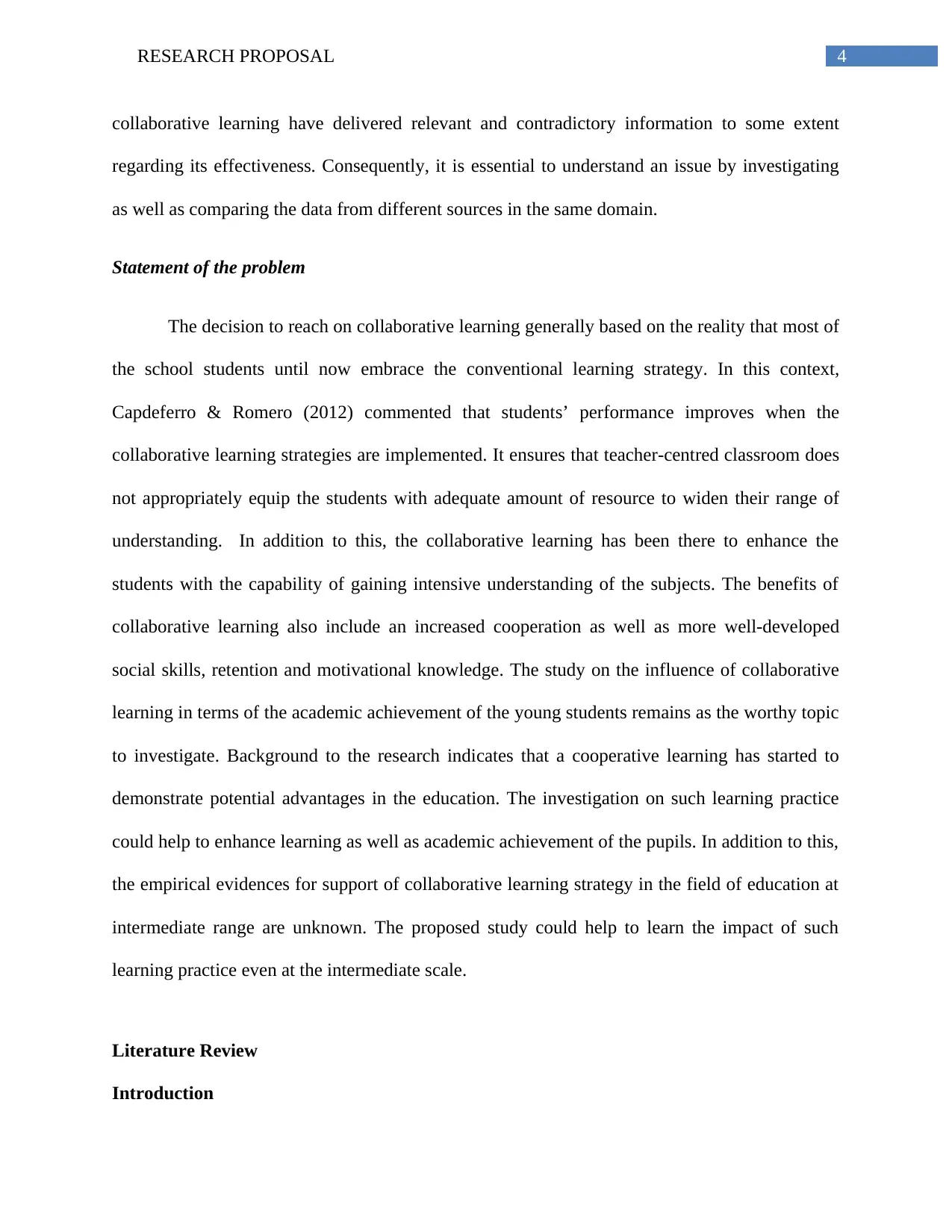
4RESEARCH PROPOSAL
collaborative learning have delivered relevant and contradictory information to some extent
regarding its effectiveness. Consequently, it is essential to understand an issue by investigating
as well as comparing the data from different sources in the same domain.
Statement of the problem
The decision to reach on collaborative learning generally based on the reality that most of
the school students until now embrace the conventional learning strategy. In this context,
Capdeferro & Romero (2012) commented that students’ performance improves when the
collaborative learning strategies are implemented. It ensures that teacher-centred classroom does
not appropriately equip the students with adequate amount of resource to widen their range of
understanding. In addition to this, the collaborative learning has been there to enhance the
students with the capability of gaining intensive understanding of the subjects. The benefits of
collaborative learning also include an increased cooperation as well as more well-developed
social skills, retention and motivational knowledge. The study on the influence of collaborative
learning in terms of the academic achievement of the young students remains as the worthy topic
to investigate. Background to the research indicates that a cooperative learning has started to
demonstrate potential advantages in the education. The investigation on such learning practice
could help to enhance learning as well as academic achievement of the pupils. In addition to this,
the empirical evidences for support of collaborative learning strategy in the field of education at
intermediate range are unknown. The proposed study could help to learn the impact of such
learning practice even at the intermediate scale.
Literature Review
Introduction
collaborative learning have delivered relevant and contradictory information to some extent
regarding its effectiveness. Consequently, it is essential to understand an issue by investigating
as well as comparing the data from different sources in the same domain.
Statement of the problem
The decision to reach on collaborative learning generally based on the reality that most of
the school students until now embrace the conventional learning strategy. In this context,
Capdeferro & Romero (2012) commented that students’ performance improves when the
collaborative learning strategies are implemented. It ensures that teacher-centred classroom does
not appropriately equip the students with adequate amount of resource to widen their range of
understanding. In addition to this, the collaborative learning has been there to enhance the
students with the capability of gaining intensive understanding of the subjects. The benefits of
collaborative learning also include an increased cooperation as well as more well-developed
social skills, retention and motivational knowledge. The study on the influence of collaborative
learning in terms of the academic achievement of the young students remains as the worthy topic
to investigate. Background to the research indicates that a cooperative learning has started to
demonstrate potential advantages in the education. The investigation on such learning practice
could help to enhance learning as well as academic achievement of the pupils. In addition to this,
the empirical evidences for support of collaborative learning strategy in the field of education at
intermediate range are unknown. The proposed study could help to learn the impact of such
learning practice even at the intermediate scale.
Literature Review
Introduction
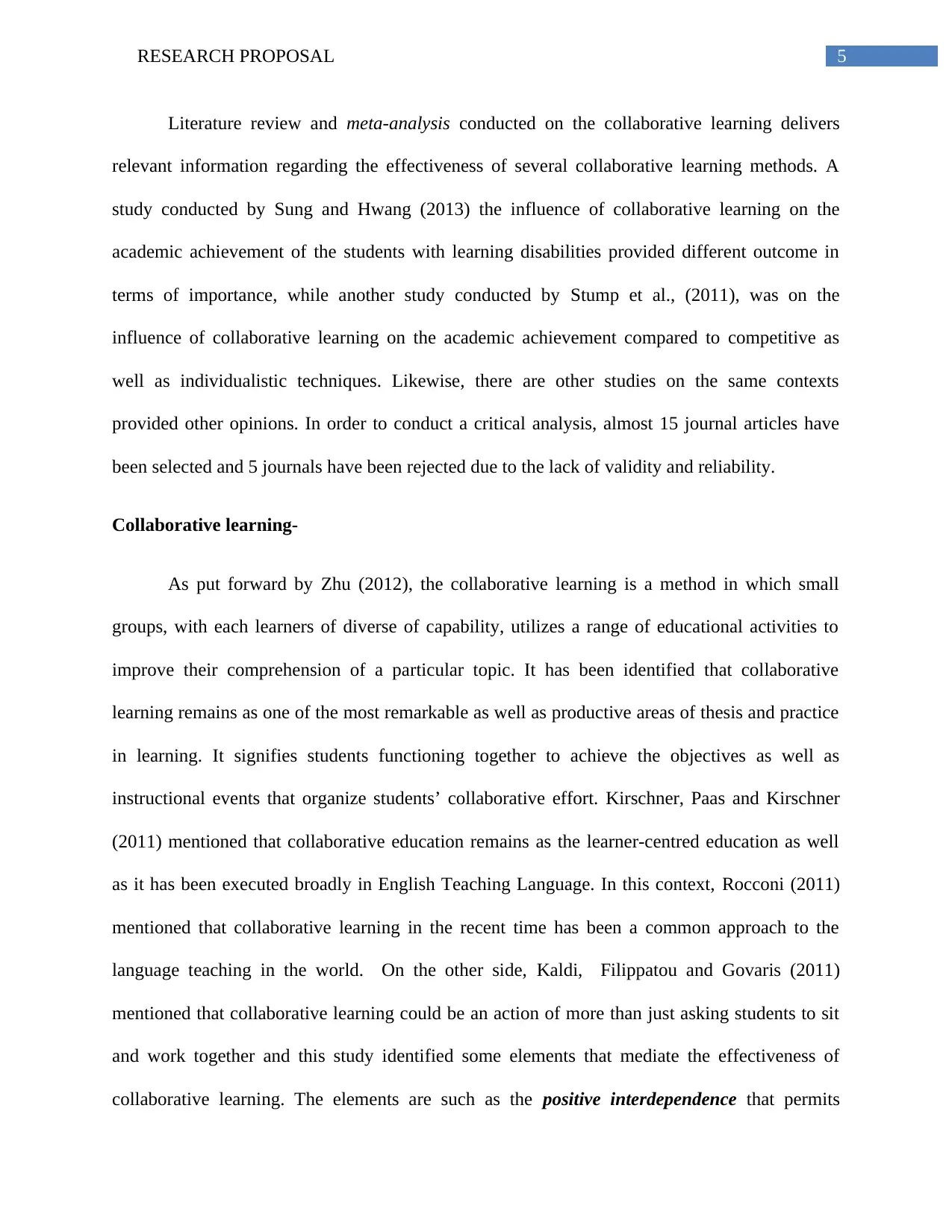
5RESEARCH PROPOSAL
Literature review and meta-analysis conducted on the collaborative learning delivers
relevant information regarding the effectiveness of several collaborative learning methods. A
study conducted by Sung and Hwang (2013) the influence of collaborative learning on the
academic achievement of the students with learning disabilities provided different outcome in
terms of importance, while another study conducted by Stump et al., (2011), was on the
influence of collaborative learning on the academic achievement compared to competitive as
well as individualistic techniques. Likewise, there are other studies on the same contexts
provided other opinions. In order to conduct a critical analysis, almost 15 journal articles have
been selected and 5 journals have been rejected due to the lack of validity and reliability.
Collaborative learning-
As put forward by Zhu (2012), the collaborative learning is a method in which small
groups, with each learners of diverse of capability, utilizes a range of educational activities to
improve their comprehension of a particular topic. It has been identified that collaborative
learning remains as one of the most remarkable as well as productive areas of thesis and practice
in learning. It signifies students functioning together to achieve the objectives as well as
instructional events that organize students’ collaborative effort. Kirschner, Paas and Kirschner
(2011) mentioned that collaborative education remains as the learner-centred education as well
as it has been executed broadly in English Teaching Language. In this context, Rocconi (2011)
mentioned that collaborative learning in the recent time has been a common approach to the
language teaching in the world. On the other side, Kaldi, Filippatou and Govaris (2011)
mentioned that collaborative learning could be an action of more than just asking students to sit
and work together and this study identified some elements that mediate the effectiveness of
collaborative learning. The elements are such as the positive interdependence that permits
Literature review and meta-analysis conducted on the collaborative learning delivers
relevant information regarding the effectiveness of several collaborative learning methods. A
study conducted by Sung and Hwang (2013) the influence of collaborative learning on the
academic achievement of the students with learning disabilities provided different outcome in
terms of importance, while another study conducted by Stump et al., (2011), was on the
influence of collaborative learning on the academic achievement compared to competitive as
well as individualistic techniques. Likewise, there are other studies on the same contexts
provided other opinions. In order to conduct a critical analysis, almost 15 journal articles have
been selected and 5 journals have been rejected due to the lack of validity and reliability.
Collaborative learning-
As put forward by Zhu (2012), the collaborative learning is a method in which small
groups, with each learners of diverse of capability, utilizes a range of educational activities to
improve their comprehension of a particular topic. It has been identified that collaborative
learning remains as one of the most remarkable as well as productive areas of thesis and practice
in learning. It signifies students functioning together to achieve the objectives as well as
instructional events that organize students’ collaborative effort. Kirschner, Paas and Kirschner
(2011) mentioned that collaborative education remains as the learner-centred education as well
as it has been executed broadly in English Teaching Language. In this context, Rocconi (2011)
mentioned that collaborative learning in the recent time has been a common approach to the
language teaching in the world. On the other side, Kaldi, Filippatou and Govaris (2011)
mentioned that collaborative learning could be an action of more than just asking students to sit
and work together and this study identified some elements that mediate the effectiveness of
collaborative learning. The elements are such as the positive interdependence that permits
You're viewing a preview
Unlock full access by subscribing today!
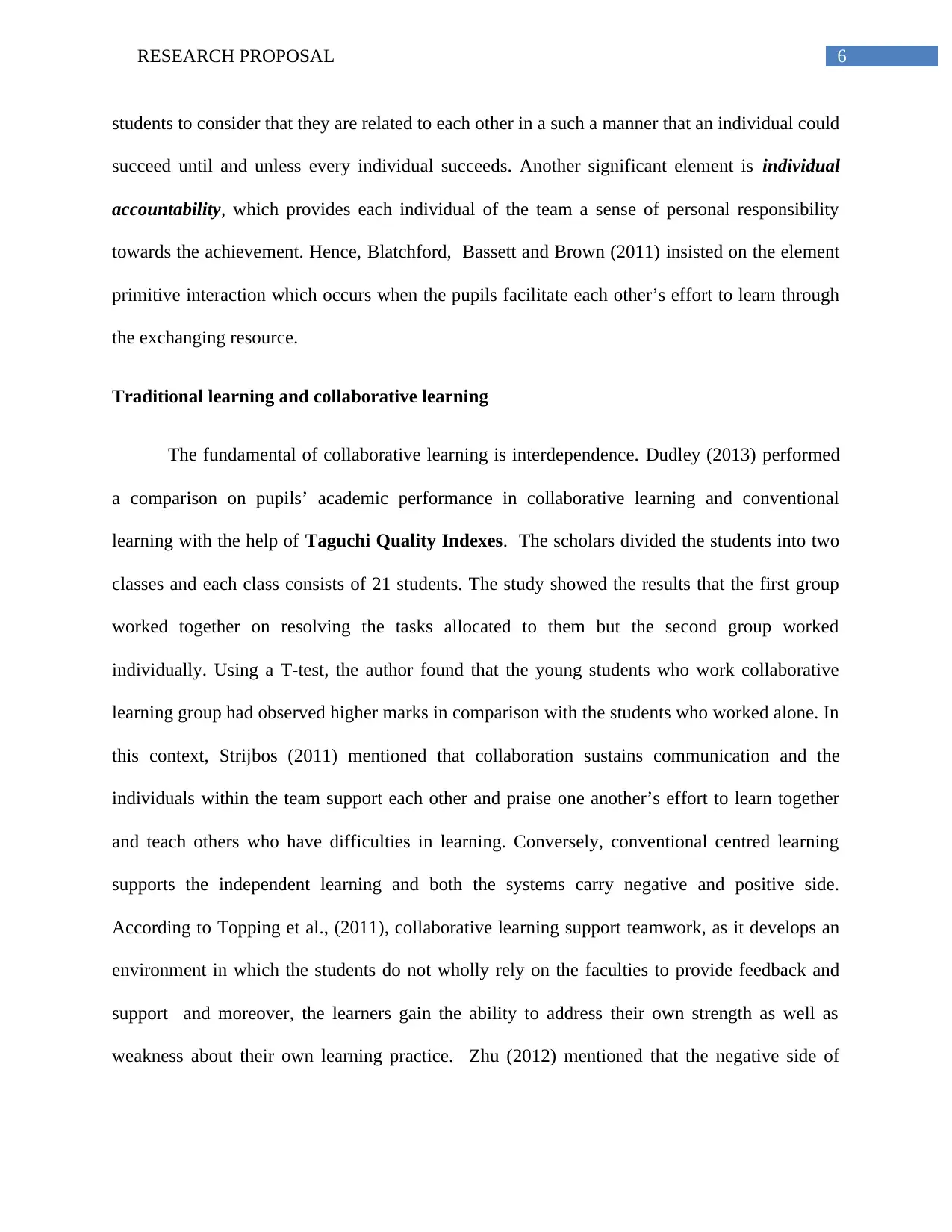
6RESEARCH PROPOSAL
students to consider that they are related to each other in a such a manner that an individual could
succeed until and unless every individual succeeds. Another significant element is individual
accountability, which provides each individual of the team a sense of personal responsibility
towards the achievement. Hence, Blatchford, Bassett and Brown (2011) insisted on the element
primitive interaction which occurs when the pupils facilitate each other’s effort to learn through
the exchanging resource.
Traditional learning and collaborative learning
The fundamental of collaborative learning is interdependence. Dudley (2013) performed
a comparison on pupils’ academic performance in collaborative learning and conventional
learning with the help of Taguchi Quality Indexes. The scholars divided the students into two
classes and each class consists of 21 students. The study showed the results that the first group
worked together on resolving the tasks allocated to them but the second group worked
individually. Using a T-test, the author found that the young students who work collaborative
learning group had observed higher marks in comparison with the students who worked alone. In
this context, Strijbos (2011) mentioned that collaboration sustains communication and the
individuals within the team support each other and praise one another’s effort to learn together
and teach others who have difficulties in learning. Conversely, conventional centred learning
supports the independent learning and both the systems carry negative and positive side.
According to Topping et al., (2011), collaborative learning support teamwork, as it develops an
environment in which the students do not wholly rely on the faculties to provide feedback and
support and moreover, the learners gain the ability to address their own strength as well as
weakness about their own learning practice. Zhu (2012) mentioned that the negative side of
students to consider that they are related to each other in a such a manner that an individual could
succeed until and unless every individual succeeds. Another significant element is individual
accountability, which provides each individual of the team a sense of personal responsibility
towards the achievement. Hence, Blatchford, Bassett and Brown (2011) insisted on the element
primitive interaction which occurs when the pupils facilitate each other’s effort to learn through
the exchanging resource.
Traditional learning and collaborative learning
The fundamental of collaborative learning is interdependence. Dudley (2013) performed
a comparison on pupils’ academic performance in collaborative learning and conventional
learning with the help of Taguchi Quality Indexes. The scholars divided the students into two
classes and each class consists of 21 students. The study showed the results that the first group
worked together on resolving the tasks allocated to them but the second group worked
individually. Using a T-test, the author found that the young students who work collaborative
learning group had observed higher marks in comparison with the students who worked alone. In
this context, Strijbos (2011) mentioned that collaboration sustains communication and the
individuals within the team support each other and praise one another’s effort to learn together
and teach others who have difficulties in learning. Conversely, conventional centred learning
supports the independent learning and both the systems carry negative and positive side.
According to Topping et al., (2011), collaborative learning support teamwork, as it develops an
environment in which the students do not wholly rely on the faculties to provide feedback and
support and moreover, the learners gain the ability to address their own strength as well as
weakness about their own learning practice. Zhu (2012) mentioned that the negative side of
Paraphrase This Document
Need a fresh take? Get an instant paraphrase of this document with our AI Paraphraser
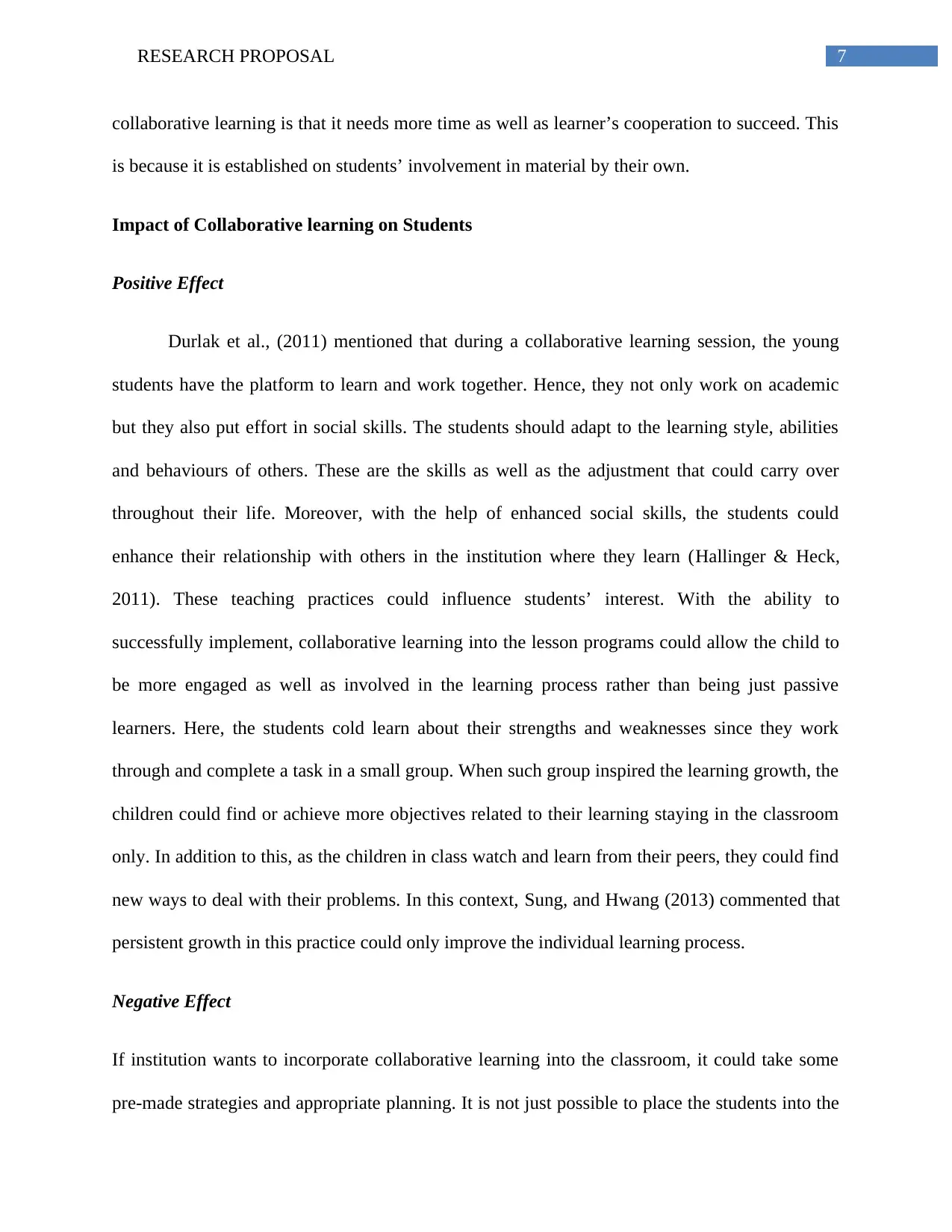
7RESEARCH PROPOSAL
collaborative learning is that it needs more time as well as learner’s cooperation to succeed. This
is because it is established on students’ involvement in material by their own.
Impact of Collaborative learning on Students
Positive Effect
Durlak et al., (2011) mentioned that during a collaborative learning session, the young
students have the platform to learn and work together. Hence, they not only work on academic
but they also put effort in social skills. The students should adapt to the learning style, abilities
and behaviours of others. These are the skills as well as the adjustment that could carry over
throughout their life. Moreover, with the help of enhanced social skills, the students could
enhance their relationship with others in the institution where they learn (Hallinger & Heck,
2011). These teaching practices could influence students’ interest. With the ability to
successfully implement, collaborative learning into the lesson programs could allow the child to
be more engaged as well as involved in the learning process rather than being just passive
learners. Here, the students cold learn about their strengths and weaknesses since they work
through and complete a task in a small group. When such group inspired the learning growth, the
children could find or achieve more objectives related to their learning staying in the classroom
only. In addition to this, as the children in class watch and learn from their peers, they could find
new ways to deal with their problems. In this context, Sung, and Hwang (2013) commented that
persistent growth in this practice could only improve the individual learning process.
Negative Effect
If institution wants to incorporate collaborative learning into the classroom, it could take some
pre-made strategies and appropriate planning. It is not just possible to place the students into the
collaborative learning is that it needs more time as well as learner’s cooperation to succeed. This
is because it is established on students’ involvement in material by their own.
Impact of Collaborative learning on Students
Positive Effect
Durlak et al., (2011) mentioned that during a collaborative learning session, the young
students have the platform to learn and work together. Hence, they not only work on academic
but they also put effort in social skills. The students should adapt to the learning style, abilities
and behaviours of others. These are the skills as well as the adjustment that could carry over
throughout their life. Moreover, with the help of enhanced social skills, the students could
enhance their relationship with others in the institution where they learn (Hallinger & Heck,
2011). These teaching practices could influence students’ interest. With the ability to
successfully implement, collaborative learning into the lesson programs could allow the child to
be more engaged as well as involved in the learning process rather than being just passive
learners. Here, the students cold learn about their strengths and weaknesses since they work
through and complete a task in a small group. When such group inspired the learning growth, the
children could find or achieve more objectives related to their learning staying in the classroom
only. In addition to this, as the children in class watch and learn from their peers, they could find
new ways to deal with their problems. In this context, Sung, and Hwang (2013) commented that
persistent growth in this practice could only improve the individual learning process.
Negative Effect
If institution wants to incorporate collaborative learning into the classroom, it could take some
pre-made strategies and appropriate planning. It is not just possible to place the students into the
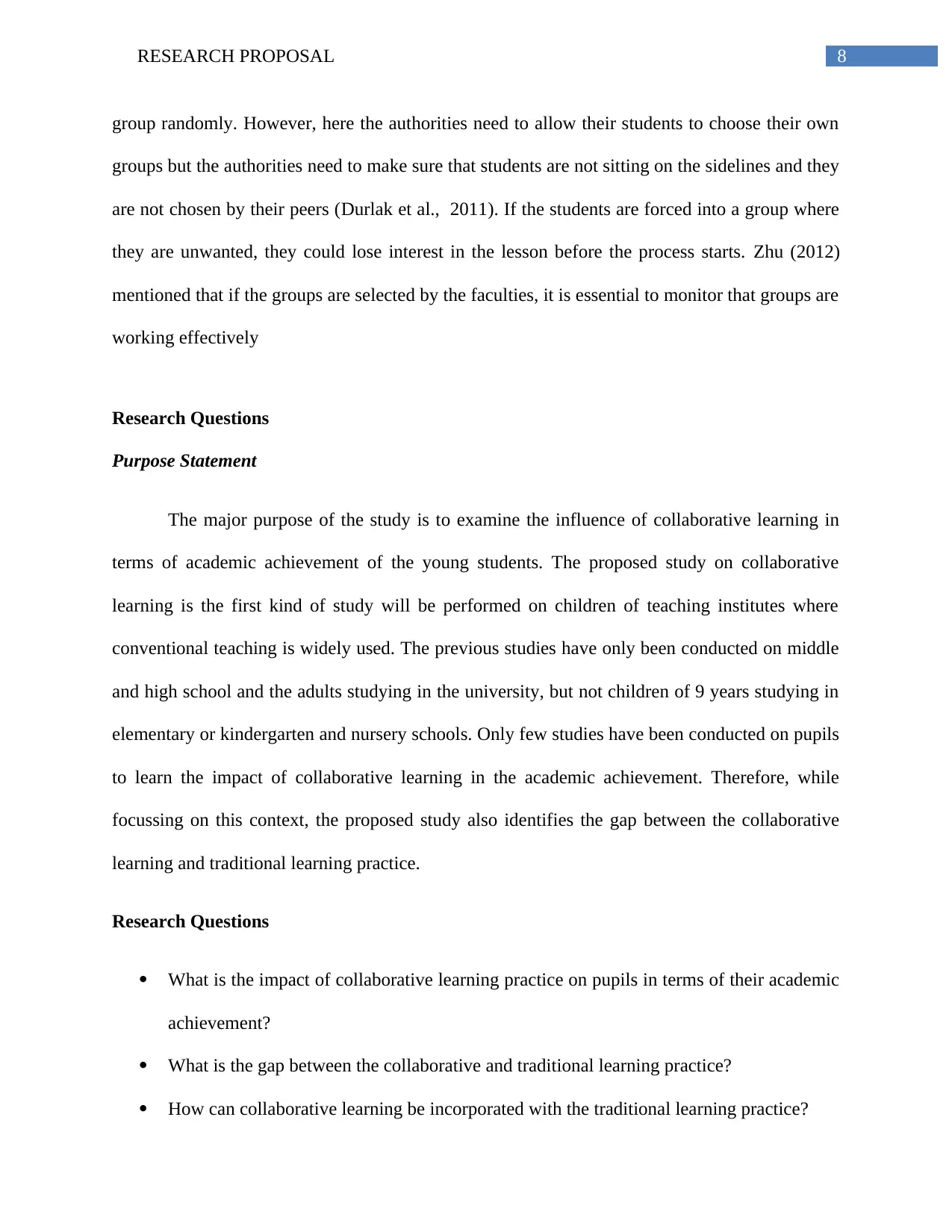
8RESEARCH PROPOSAL
group randomly. However, here the authorities need to allow their students to choose their own
groups but the authorities need to make sure that students are not sitting on the sidelines and they
are not chosen by their peers (Durlak et al., 2011). If the students are forced into a group where
they are unwanted, they could lose interest in the lesson before the process starts. Zhu (2012)
mentioned that if the groups are selected by the faculties, it is essential to monitor that groups are
working effectively
Research Questions
Purpose Statement
The major purpose of the study is to examine the influence of collaborative learning in
terms of academic achievement of the young students. The proposed study on collaborative
learning is the first kind of study will be performed on children of teaching institutes where
conventional teaching is widely used. The previous studies have only been conducted on middle
and high school and the adults studying in the university, but not children of 9 years studying in
elementary or kindergarten and nursery schools. Only few studies have been conducted on pupils
to learn the impact of collaborative learning in the academic achievement. Therefore, while
focussing on this context, the proposed study also identifies the gap between the collaborative
learning and traditional learning practice.
Research Questions
What is the impact of collaborative learning practice on pupils in terms of their academic
achievement?
What is the gap between the collaborative and traditional learning practice?
How can collaborative learning be incorporated with the traditional learning practice?
group randomly. However, here the authorities need to allow their students to choose their own
groups but the authorities need to make sure that students are not sitting on the sidelines and they
are not chosen by their peers (Durlak et al., 2011). If the students are forced into a group where
they are unwanted, they could lose interest in the lesson before the process starts. Zhu (2012)
mentioned that if the groups are selected by the faculties, it is essential to monitor that groups are
working effectively
Research Questions
Purpose Statement
The major purpose of the study is to examine the influence of collaborative learning in
terms of academic achievement of the young students. The proposed study on collaborative
learning is the first kind of study will be performed on children of teaching institutes where
conventional teaching is widely used. The previous studies have only been conducted on middle
and high school and the adults studying in the university, but not children of 9 years studying in
elementary or kindergarten and nursery schools. Only few studies have been conducted on pupils
to learn the impact of collaborative learning in the academic achievement. Therefore, while
focussing on this context, the proposed study also identifies the gap between the collaborative
learning and traditional learning practice.
Research Questions
What is the impact of collaborative learning practice on pupils in terms of their academic
achievement?
What is the gap between the collaborative and traditional learning practice?
How can collaborative learning be incorporated with the traditional learning practice?
You're viewing a preview
Unlock full access by subscribing today!
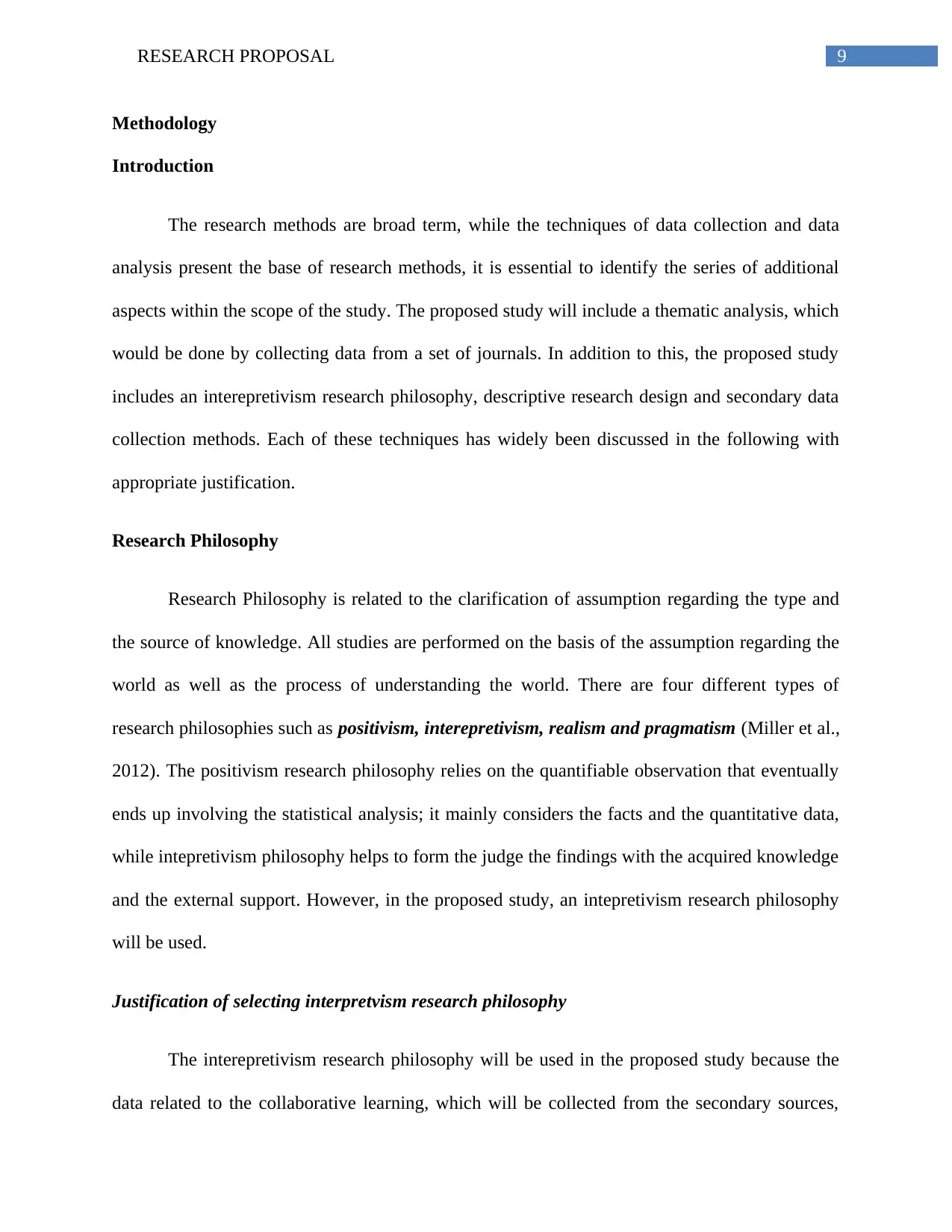
9RESEARCH PROPOSAL
Methodology
Introduction
The research methods are broad term, while the techniques of data collection and data
analysis present the base of research methods, it is essential to identify the series of additional
aspects within the scope of the study. The proposed study will include a thematic analysis, which
would be done by collecting data from a set of journals. In addition to this, the proposed study
includes an interepretivism research philosophy, descriptive research design and secondary data
collection methods. Each of these techniques has widely been discussed in the following with
appropriate justification.
Research Philosophy
Research Philosophy is related to the clarification of assumption regarding the type and
the source of knowledge. All studies are performed on the basis of the assumption regarding the
world as well as the process of understanding the world. There are four different types of
research philosophies such as positivism, interepretivism, realism and pragmatism (Miller et al.,
2012). The positivism research philosophy relies on the quantifiable observation that eventually
ends up involving the statistical analysis; it mainly considers the facts and the quantitative data,
while intepretivism philosophy helps to form the judge the findings with the acquired knowledge
and the external support. However, in the proposed study, an intepretivism research philosophy
will be used.
Justification of selecting interpretvism research philosophy
The interepretivism research philosophy will be used in the proposed study because the
data related to the collaborative learning, which will be collected from the secondary sources,
Methodology
Introduction
The research methods are broad term, while the techniques of data collection and data
analysis present the base of research methods, it is essential to identify the series of additional
aspects within the scope of the study. The proposed study will include a thematic analysis, which
would be done by collecting data from a set of journals. In addition to this, the proposed study
includes an interepretivism research philosophy, descriptive research design and secondary data
collection methods. Each of these techniques has widely been discussed in the following with
appropriate justification.
Research Philosophy
Research Philosophy is related to the clarification of assumption regarding the type and
the source of knowledge. All studies are performed on the basis of the assumption regarding the
world as well as the process of understanding the world. There are four different types of
research philosophies such as positivism, interepretivism, realism and pragmatism (Miller et al.,
2012). The positivism research philosophy relies on the quantifiable observation that eventually
ends up involving the statistical analysis; it mainly considers the facts and the quantitative data,
while intepretivism philosophy helps to form the judge the findings with the acquired knowledge
and the external support. However, in the proposed study, an intepretivism research philosophy
will be used.
Justification of selecting interpretvism research philosophy
The interepretivism research philosophy will be used in the proposed study because the
data related to the collaborative learning, which will be collected from the secondary sources,
Paraphrase This Document
Need a fresh take? Get an instant paraphrase of this document with our AI Paraphraser
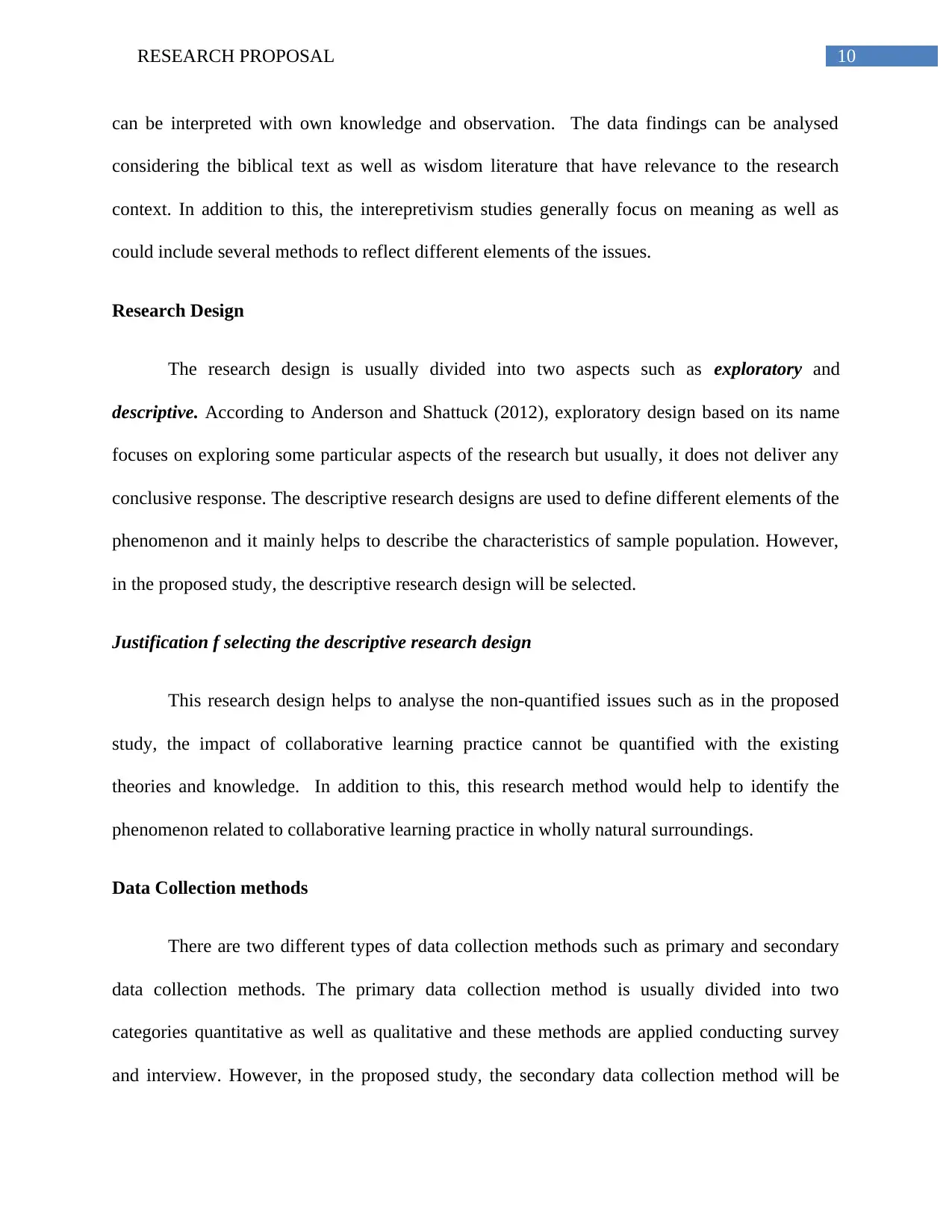
10RESEARCH PROPOSAL
can be interpreted with own knowledge and observation. The data findings can be analysed
considering the biblical text as well as wisdom literature that have relevance to the research
context. In addition to this, the interepretivism studies generally focus on meaning as well as
could include several methods to reflect different elements of the issues.
Research Design
The research design is usually divided into two aspects such as exploratory and
descriptive. According to Anderson and Shattuck (2012), exploratory design based on its name
focuses on exploring some particular aspects of the research but usually, it does not deliver any
conclusive response. The descriptive research designs are used to define different elements of the
phenomenon and it mainly helps to describe the characteristics of sample population. However,
in the proposed study, the descriptive research design will be selected.
Justification f selecting the descriptive research design
This research design helps to analyse the non-quantified issues such as in the proposed
study, the impact of collaborative learning practice cannot be quantified with the existing
theories and knowledge. In addition to this, this research method would help to identify the
phenomenon related to collaborative learning practice in wholly natural surroundings.
Data Collection methods
There are two different types of data collection methods such as primary and secondary
data collection methods. The primary data collection method is usually divided into two
categories quantitative as well as qualitative and these methods are applied conducting survey
and interview. However, in the proposed study, the secondary data collection method will be
can be interpreted with own knowledge and observation. The data findings can be analysed
considering the biblical text as well as wisdom literature that have relevance to the research
context. In addition to this, the interepretivism studies generally focus on meaning as well as
could include several methods to reflect different elements of the issues.
Research Design
The research design is usually divided into two aspects such as exploratory and
descriptive. According to Anderson and Shattuck (2012), exploratory design based on its name
focuses on exploring some particular aspects of the research but usually, it does not deliver any
conclusive response. The descriptive research designs are used to define different elements of the
phenomenon and it mainly helps to describe the characteristics of sample population. However,
in the proposed study, the descriptive research design will be selected.
Justification f selecting the descriptive research design
This research design helps to analyse the non-quantified issues such as in the proposed
study, the impact of collaborative learning practice cannot be quantified with the existing
theories and knowledge. In addition to this, this research method would help to identify the
phenomenon related to collaborative learning practice in wholly natural surroundings.
Data Collection methods
There are two different types of data collection methods such as primary and secondary
data collection methods. The primary data collection method is usually divided into two
categories quantitative as well as qualitative and these methods are applied conducting survey
and interview. However, in the proposed study, the secondary data collection method will be

11RESEARCH PROPOSAL
applied. As put forward by Maxwell (2012) the secondary data is a kind of data that has already
been published in books, journals, magazines and other online portals. The secondary data will
be collected from the reliable and validated source.
Reliability and Validity
The proposed study is associated with the high level of reliability and the other scholars
in future will be able to generate the same outcome if they use same methods such as secondary
data collection process under the condition of investigating the impact of collaborative learning
on young students. The proposed study has the validity because proper time scale will be
selected and appropriate research techniques will be applied to the research.
Research Limitation
The proposed study is limited to secondary analysis only, because the primary analysis
will not be conducted in the research. Moreover, the study also lacks a comparative analysis in
terms of the techniques of collaborative learning.
Conclusion
It can be mentioned that the proposed study would provide desired outcome because all relevant
and appropriate methods will be applied to the study. The literature review indicates that
differences in the collaborative learning process exists that those are only in terms of the
techniques. The previous studies also imply that there are many institutions where collaborative
learning methods remain as the secondary choice. However, actual scenario will be revealed
once the data is gather and the findings are compared to the previous studies in the proposed
study.
applied. As put forward by Maxwell (2012) the secondary data is a kind of data that has already
been published in books, journals, magazines and other online portals. The secondary data will
be collected from the reliable and validated source.
Reliability and Validity
The proposed study is associated with the high level of reliability and the other scholars
in future will be able to generate the same outcome if they use same methods such as secondary
data collection process under the condition of investigating the impact of collaborative learning
on young students. The proposed study has the validity because proper time scale will be
selected and appropriate research techniques will be applied to the research.
Research Limitation
The proposed study is limited to secondary analysis only, because the primary analysis
will not be conducted in the research. Moreover, the study also lacks a comparative analysis in
terms of the techniques of collaborative learning.
Conclusion
It can be mentioned that the proposed study would provide desired outcome because all relevant
and appropriate methods will be applied to the study. The literature review indicates that
differences in the collaborative learning process exists that those are only in terms of the
techniques. The previous studies also imply that there are many institutions where collaborative
learning methods remain as the secondary choice. However, actual scenario will be revealed
once the data is gather and the findings are compared to the previous studies in the proposed
study.
You're viewing a preview
Unlock full access by subscribing today!

12RESEARCH PROPOSAL
Paraphrase This Document
Need a fresh take? Get an instant paraphrase of this document with our AI Paraphraser
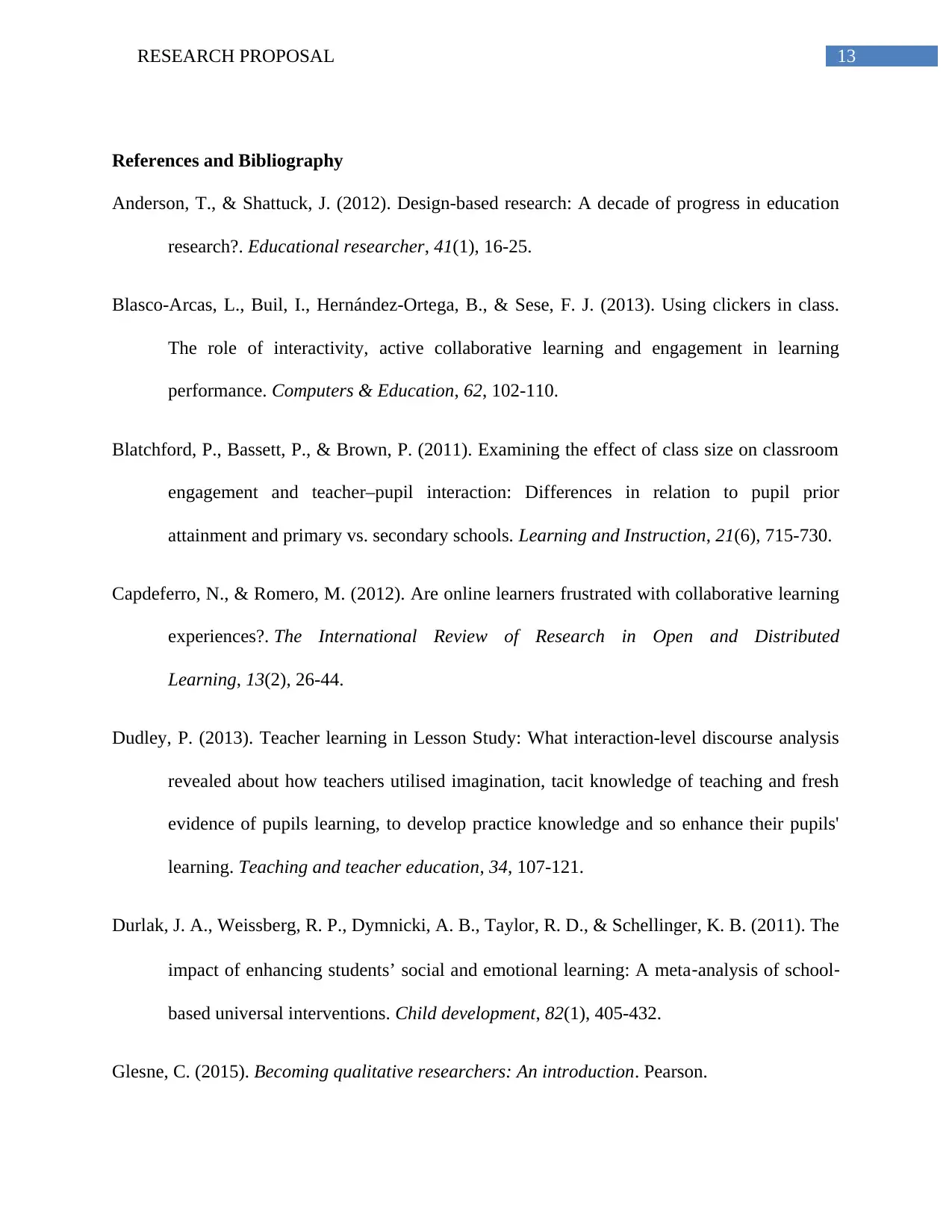
13RESEARCH PROPOSAL
References and Bibliography
Anderson, T., & Shattuck, J. (2012). Design-based research: A decade of progress in education
research?. Educational researcher, 41(1), 16-25.
Blasco-Arcas, L., Buil, I., Hernández-Ortega, B., & Sese, F. J. (2013). Using clickers in class.
The role of interactivity, active collaborative learning and engagement in learning
performance. Computers & Education, 62, 102-110.
Blatchford, P., Bassett, P., & Brown, P. (2011). Examining the effect of class size on classroom
engagement and teacher–pupil interaction: Differences in relation to pupil prior
attainment and primary vs. secondary schools. Learning and Instruction, 21(6), 715-730.
Capdeferro, N., & Romero, M. (2012). Are online learners frustrated with collaborative learning
experiences?. The International Review of Research in Open and Distributed
Learning, 13(2), 26-44.
Dudley, P. (2013). Teacher learning in Lesson Study: What interaction-level discourse analysis
revealed about how teachers utilised imagination, tacit knowledge of teaching and fresh
evidence of pupils learning, to develop practice knowledge and so enhance their pupils'
learning. Teaching and teacher education, 34, 107-121.
Durlak, J. A., Weissberg, R. P., Dymnicki, A. B., Taylor, R. D., & Schellinger, K. B. (2011). The
impact of enhancing students’ social and emotional learning: A meta‐analysis of school‐
based universal interventions. Child development, 82(1), 405-432.
Glesne, C. (2015). Becoming qualitative researchers: An introduction. Pearson.
References and Bibliography
Anderson, T., & Shattuck, J. (2012). Design-based research: A decade of progress in education
research?. Educational researcher, 41(1), 16-25.
Blasco-Arcas, L., Buil, I., Hernández-Ortega, B., & Sese, F. J. (2013). Using clickers in class.
The role of interactivity, active collaborative learning and engagement in learning
performance. Computers & Education, 62, 102-110.
Blatchford, P., Bassett, P., & Brown, P. (2011). Examining the effect of class size on classroom
engagement and teacher–pupil interaction: Differences in relation to pupil prior
attainment and primary vs. secondary schools. Learning and Instruction, 21(6), 715-730.
Capdeferro, N., & Romero, M. (2012). Are online learners frustrated with collaborative learning
experiences?. The International Review of Research in Open and Distributed
Learning, 13(2), 26-44.
Dudley, P. (2013). Teacher learning in Lesson Study: What interaction-level discourse analysis
revealed about how teachers utilised imagination, tacit knowledge of teaching and fresh
evidence of pupils learning, to develop practice knowledge and so enhance their pupils'
learning. Teaching and teacher education, 34, 107-121.
Durlak, J. A., Weissberg, R. P., Dymnicki, A. B., Taylor, R. D., & Schellinger, K. B. (2011). The
impact of enhancing students’ social and emotional learning: A meta‐analysis of school‐
based universal interventions. Child development, 82(1), 405-432.
Glesne, C. (2015). Becoming qualitative researchers: An introduction. Pearson.
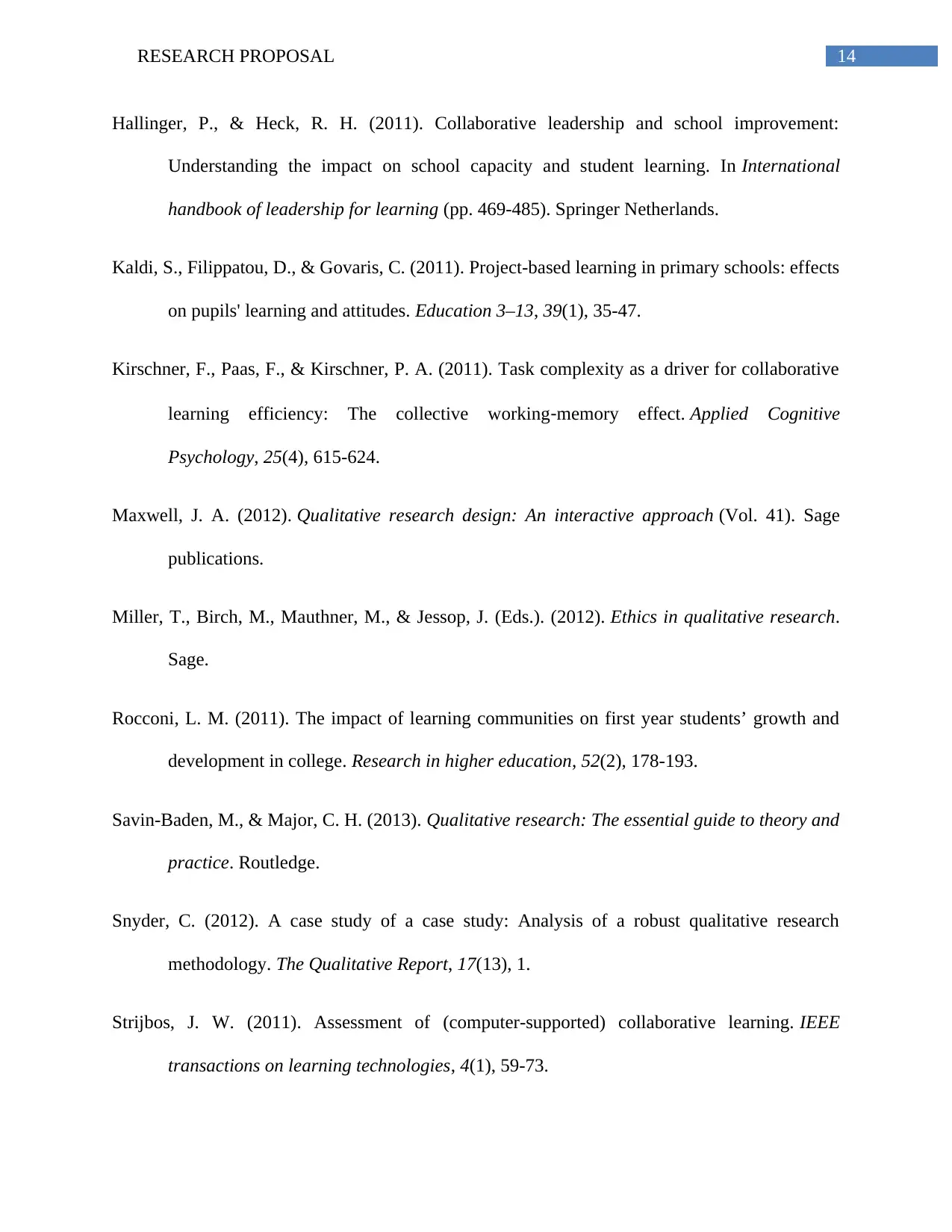
14RESEARCH PROPOSAL
Hallinger, P., & Heck, R. H. (2011). Collaborative leadership and school improvement:
Understanding the impact on school capacity and student learning. In International
handbook of leadership for learning (pp. 469-485). Springer Netherlands.
Kaldi, S., Filippatou, D., & Govaris, C. (2011). Project-based learning in primary schools: effects
on pupils' learning and attitudes. Education 3–13, 39(1), 35-47.
Kirschner, F., Paas, F., & Kirschner, P. A. (2011). Task complexity as a driver for collaborative
learning efficiency: The collective working‐memory effect. Applied Cognitive
Psychology, 25(4), 615-624.
Maxwell, J. A. (2012). Qualitative research design: An interactive approach (Vol. 41). Sage
publications.
Miller, T., Birch, M., Mauthner, M., & Jessop, J. (Eds.). (2012). Ethics in qualitative research.
Sage.
Rocconi, L. M. (2011). The impact of learning communities on first year students’ growth and
development in college. Research in higher education, 52(2), 178-193.
Savin-Baden, M., & Major, C. H. (2013). Qualitative research: The essential guide to theory and
practice. Routledge.
Snyder, C. (2012). A case study of a case study: Analysis of a robust qualitative research
methodology. The Qualitative Report, 17(13), 1.
Strijbos, J. W. (2011). Assessment of (computer-supported) collaborative learning. IEEE
transactions on learning technologies, 4(1), 59-73.
Hallinger, P., & Heck, R. H. (2011). Collaborative leadership and school improvement:
Understanding the impact on school capacity and student learning. In International
handbook of leadership for learning (pp. 469-485). Springer Netherlands.
Kaldi, S., Filippatou, D., & Govaris, C. (2011). Project-based learning in primary schools: effects
on pupils' learning and attitudes. Education 3–13, 39(1), 35-47.
Kirschner, F., Paas, F., & Kirschner, P. A. (2011). Task complexity as a driver for collaborative
learning efficiency: The collective working‐memory effect. Applied Cognitive
Psychology, 25(4), 615-624.
Maxwell, J. A. (2012). Qualitative research design: An interactive approach (Vol. 41). Sage
publications.
Miller, T., Birch, M., Mauthner, M., & Jessop, J. (Eds.). (2012). Ethics in qualitative research.
Sage.
Rocconi, L. M. (2011). The impact of learning communities on first year students’ growth and
development in college. Research in higher education, 52(2), 178-193.
Savin-Baden, M., & Major, C. H. (2013). Qualitative research: The essential guide to theory and
practice. Routledge.
Snyder, C. (2012). A case study of a case study: Analysis of a robust qualitative research
methodology. The Qualitative Report, 17(13), 1.
Strijbos, J. W. (2011). Assessment of (computer-supported) collaborative learning. IEEE
transactions on learning technologies, 4(1), 59-73.
You're viewing a preview
Unlock full access by subscribing today!
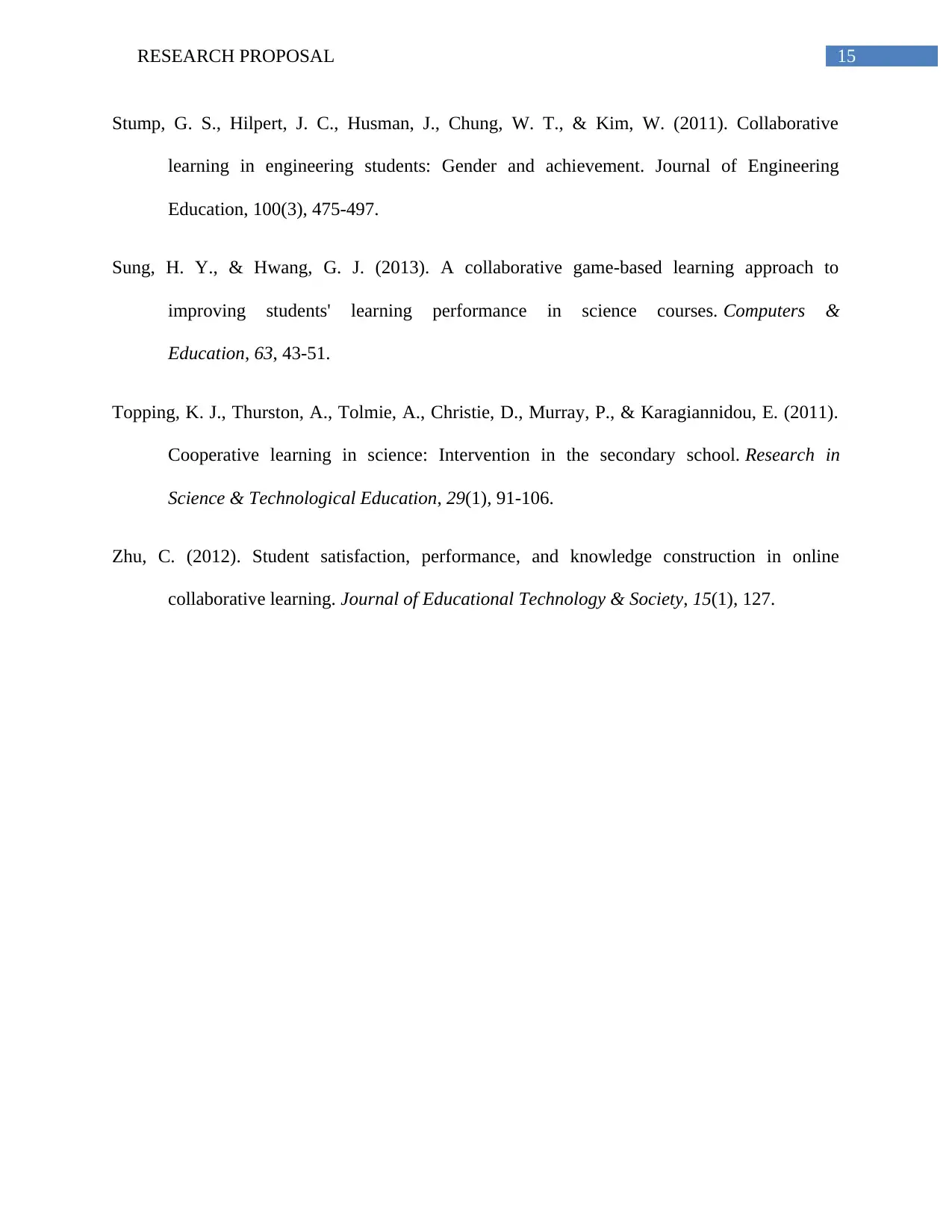
15RESEARCH PROPOSAL
Stump, G. S., Hilpert, J. C., Husman, J., Chung, W. T., & Kim, W. (2011). Collaborative
learning in engineering students: Gender and achievement. Journal of Engineering
Education, 100(3), 475-497.
Sung, H. Y., & Hwang, G. J. (2013). A collaborative game-based learning approach to
improving students' learning performance in science courses. Computers &
Education, 63, 43-51.
Topping, K. J., Thurston, A., Tolmie, A., Christie, D., Murray, P., & Karagiannidou, E. (2011).
Cooperative learning in science: Intervention in the secondary school. Research in
Science & Technological Education, 29(1), 91-106.
Zhu, C. (2012). Student satisfaction, performance, and knowledge construction in online
collaborative learning. Journal of Educational Technology & Society, 15(1), 127.
Stump, G. S., Hilpert, J. C., Husman, J., Chung, W. T., & Kim, W. (2011). Collaborative
learning in engineering students: Gender and achievement. Journal of Engineering
Education, 100(3), 475-497.
Sung, H. Y., & Hwang, G. J. (2013). A collaborative game-based learning approach to
improving students' learning performance in science courses. Computers &
Education, 63, 43-51.
Topping, K. J., Thurston, A., Tolmie, A., Christie, D., Murray, P., & Karagiannidou, E. (2011).
Cooperative learning in science: Intervention in the secondary school. Research in
Science & Technological Education, 29(1), 91-106.
Zhu, C. (2012). Student satisfaction, performance, and knowledge construction in online
collaborative learning. Journal of Educational Technology & Society, 15(1), 127.
1 out of 16
Related Documents
Your All-in-One AI-Powered Toolkit for Academic Success.
+13062052269
info@desklib.com
Available 24*7 on WhatsApp / Email
![[object Object]](/_next/static/media/star-bottom.7253800d.svg)
Unlock your academic potential
© 2024 | Zucol Services PVT LTD | All rights reserved.





